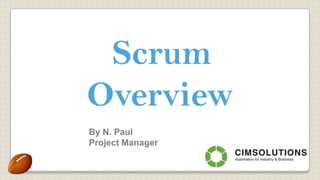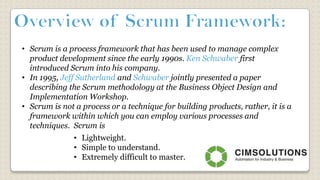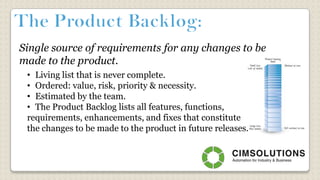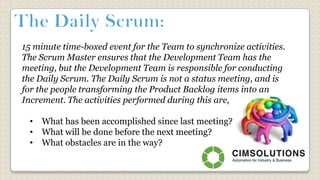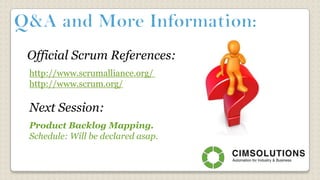Scrum overview
- 1. Scrum Overview By N. Paul Project Manager
- 2. âĒ Scrum is a process framework that has been used to manage complex product development since the early 1990s. Ken Schwaber first introduced Scrum into his company. âĒ In 1995, Jeff Sutherland and Schwaber jointly presented a paper describing the Scrum methodology at the Business Object Design and Implementation Workshop. âĒ Scrum is not a process or a technique for building products, rather, it is a framework within which you can employ various processes and techniques. Scrum is âĒ Lightweight. âĒ Simple to understand. âĒ Extremely difficult to master.
- 4. There are three core roles and a range of ancillary roles. Core roles are often referred to as pigs and ancillary roles as chickens(reference link). Core roles are , âĒ The Product Owner. âĒ The Development Team. âĒ The Scrum Master. Ancillery roles are, âĒ Project Manager. âĒ The Project Executive and Project Board. âĒ Project Assurance. âĒ Managers. âĒ Stakeholders.
- 5. The product owner is commonly a lead user of the system or someone from marketing, product management or anyone with a solid understanding of users, the market place, the competition and of future trends for the domain or type of system being developed. Responsible for the product backlog and maximizing the product ROI. âĒ Represents the users. âĒ Clearly expressing Product Backlog items. âĒ Ordering the items in the Product Backlog to best achieve goals and missions. âĒ Ensuring that the Product Backlog is visible, transparent, and clear to all, and shows what the Scrum Team will work on next.
- 6. Responsible for delivering a potentially shippable increment of working software. âĒ They are self-organizing. No one (not even the Scrum Master) tells the Development Team how to turn Product Backlog into Increments of potentially releasable functionality. âĒ Development Teams are cross-functional, with all of the skills as a team necessary to create a product Increment. âĒ Individual Development Team members may have specialized skills and areas of focus, but accountability belongs to the Development Team as a whole. âĒ Can consists of 4 to 9 persons. âĒ The Product Owner and Scrum Master roles are not included in this count unless they are also executing the work of the Sprint Backlogâs.
- 7. Responsible for the entire scrum process. Scrum Masters do this by ensuring that the Scrum Team adheres to Scrum theory, practices, and rules. âĒ Removes impediments the development team is facing. âĒ Understanding and practicing agility. âĒ Facilitating Scrum events as requested or needed. âĒ Facilitates communication. âĒ Finding techniques for effective Product Backlog management. âĒ Leading and coaching the organization in its Scrum adoption. âĒ Planning Scrum implementations within the organization.
- 8. Single source of requirements for any changes to be made to the product. âĒ Living list that is never complete. âĒ Ordered: value, risk, priority & necessity. âĒ Estimated by the team. âĒ The Product Backlog lists all features, functions, requirements, enhancements, and fixes that constitute the changes to be made to the product in future releases.
- 9. Used to assess when work is complete on the product increment. âĒ Defined by the product owner. âĒ Unique for the whole team. âĒ Must allow immediate release. âĒ Quality increases with maturity.
- 10. Two part time boxed meeting: 8h/1m sprint. The work to be performed in the Sprint is planned at the Sprint Planning Meeting. This plan is created by the collaborative work of the entire Scrum Team. The two part of activities need to be discussed are 1. Defines what will be delivered in the increment: âĒ Team selects items from the product backlog and defines a sprint goal. (Involvement: Product owner, Scrum Master, Development Team). 2. Defines how the increment will be achieved: âĒ Items are converted into tasks & estimated (Involvement: Scrum Master and development team).
- 11. 15 minute time-boxed event for the Team to synchronize activities. The Scrum Master ensures that the Development Team has the meeting, but the Development Team is responsible for conducting the Daily Scrum. The Daily Scrum is not a status meeting, and is for the people transforming the Product Backlog items into an Increment. The activities performed during this are, âĒ What has been accomplished since last meeting? âĒ What will be done before the next meeting? âĒ What obstacles are in the way?
- 12. This is a 4 hour time-boxed meeting: âĒ Product owner identifies what has been done and not done. âĒ Team discusses what went well, what problems it ran into & how those problem were solved. âĒ Team demonstrates what it has done in a demo. âĒ Product owner discusses the backlog as it stands. âĒ Entire group collaborates on what to do next.
- 13. Improves the process. âĒ Inspect how the last Sprint went, âĒ Identify and order the major items that went well and potential improvements done, and, âĒ Create a plan for implementing improvements.
- 14. Official Scrum References: http://www.scrumalliance.org/ http://www.scrum.org/ Next Session: Product Backlog Mapping. Schedule: Will be declared asap.

